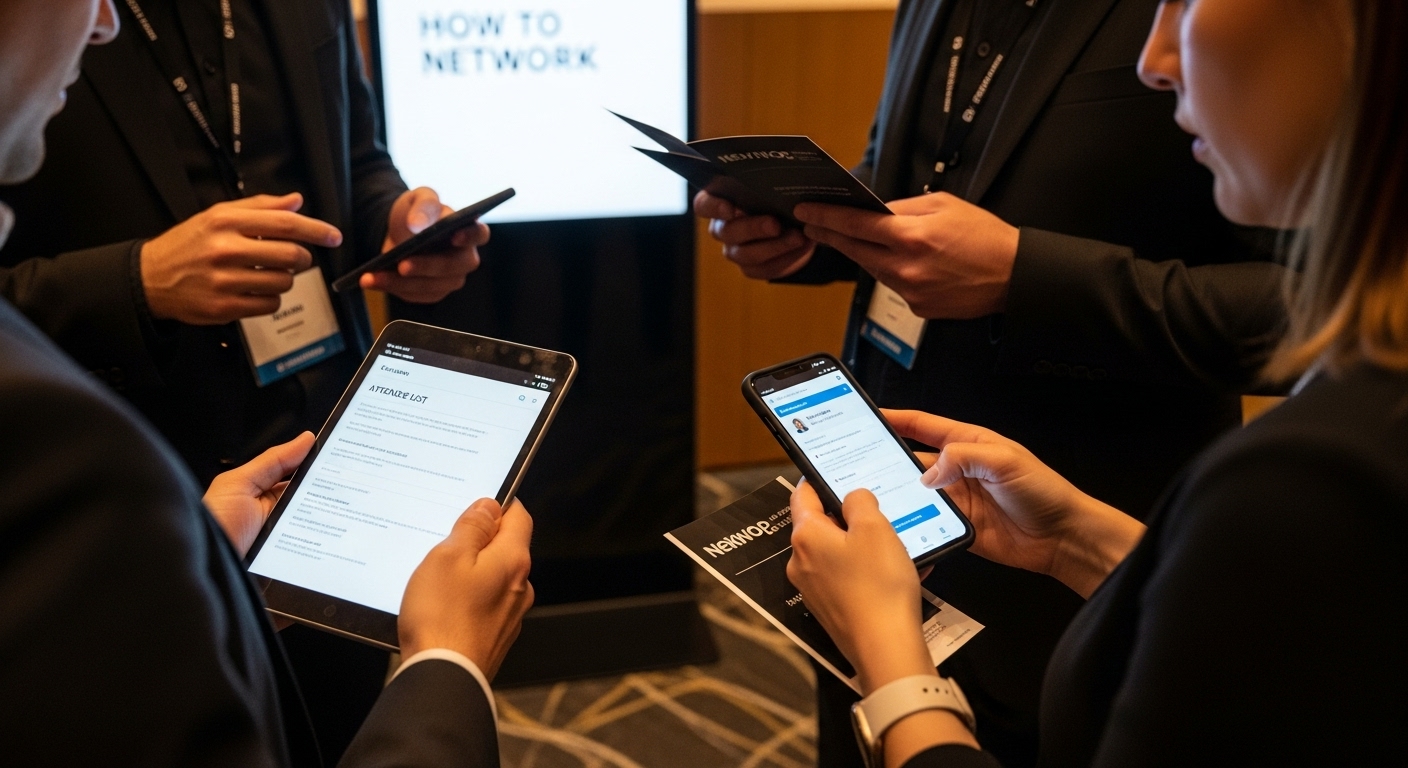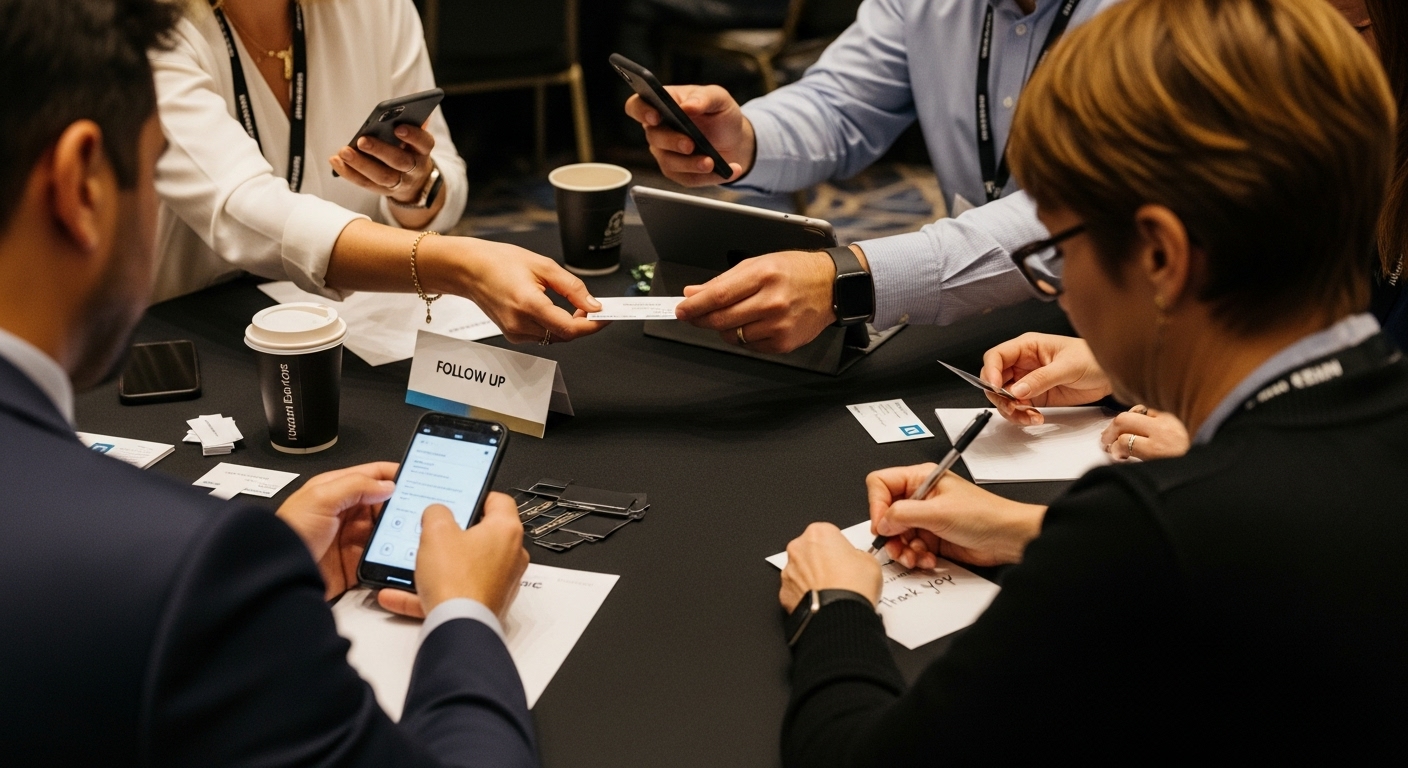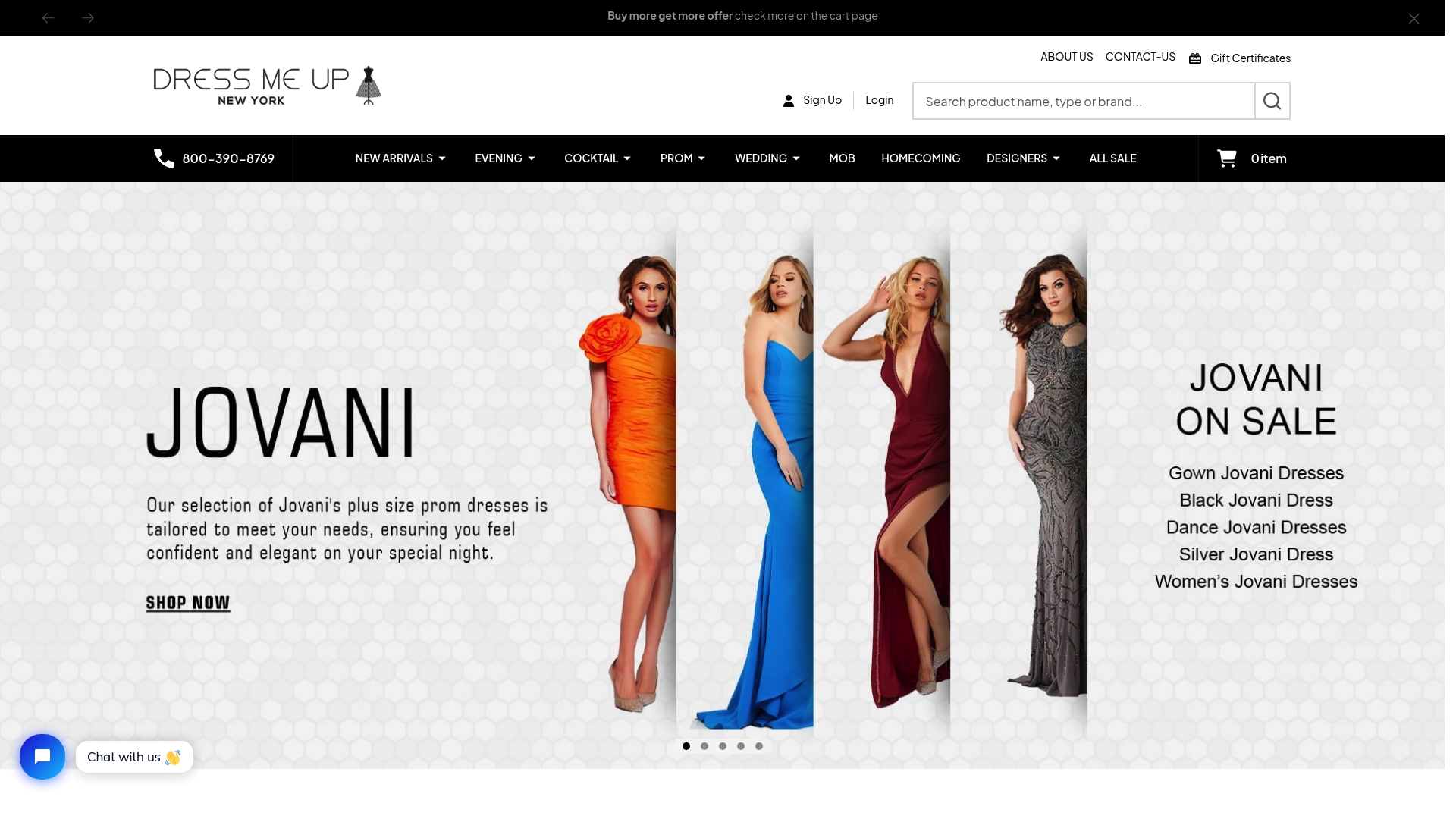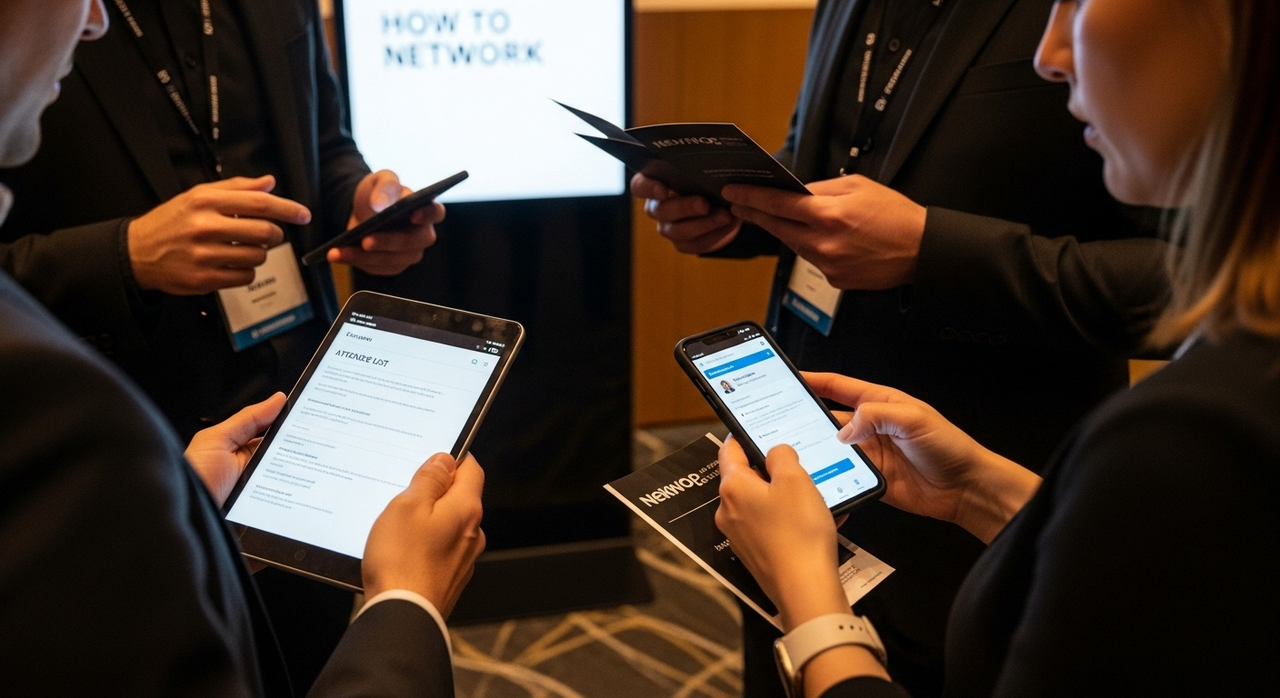How to Network at Events: Build Connections Effectively
How to Network at Events: Build Connections Effectively

Mastering networking can unlock hidden doors in your career and personal growth, yet most people feel lost the moment they enter a crowded event. Surprisingly, research shows that most meaningful connections come from strategic preparation long before any introductions happen. The real secret is that what you do before the event matters far more than what you say once you get there.
Table of Contents
- Step 1: Research The Event And Attendees
- Step 2: Prepare Your Introduction And Elevator Pitch
- Step 3: Approach And Engage With Confidence
- Step 4: Utilize Active Listening Skills
- Step 5: Follow Up With New Contacts
Quick Summary
| Key Point | Explanation |
|---|---|
| 1. Research event details thoroughly | Understand the event’s purpose, audience, and key speakers to target effective networking opportunities. |
| 2. Prepare your elevator pitch | Create a concise introduction that highlights your unique value and professional goals for impactful first impressions. |
| 3. Engage confidently and authentically | Approach conversations with genuine curiosity and open-ended questions to foster meaningful discussions. |
| 4. Master active listening skills | Show full attentiveness by summarizing points and asking thoughtful follow-up questions to deepen connections. |
| 5. Follow up promptly and personally | Send individualized messages referencing past discussions to nurture relationships and keep connections alive. |
Step 1: Research the Event and Attendees
Successful networking begins long before you walk into the event space. Preparation is the foundation of effective connection building, and researching the event and its potential attendees transforms your networking from random interactions to strategic relationship development.
Start by diving deep into the event details. Understanding the event’s purpose, theme, and target audience provides critical context for your networking strategy. Professional conferences, industry mixers, and alumni gatherings each require a nuanced approach. Look beyond basic event descriptions and examine the speaker lineup, session topics, and attendee profiles.
Leverage online platforms like LinkedIn to gather intelligence about potential connections. Review the event’s attendee list if available, or explore the professional backgrounds of confirmed participants. Pay special attention to individuals whose roles, industries, or career trajectories align with your professional goals. Create a mental map of potential meaningful conversations and connection opportunities.
Technology offers powerful tools for event research. Many professional networking platforms provide detailed attendee insights, allowing you to strategically identify and prioritize potential connections. Consider using event-specific networking apps or conference platforms that offer attendee matching features. These tools can help you preselect individuals most relevant to your networking objectives.
Before the event, develop a preliminary list of 3-5 key professionals you want to engage with. Research their recent professional achievements, published work, or notable projects. This preparation enables you to craft genuine, informed conversation starters that demonstrate your authentic interest.
![]() Avoid generic small talk by preparing specific, thoughtful questions that showcase your knowledge and curiosity.
Avoid generic small talk by preparing specific, thoughtful questions that showcase your knowledge and curiosity.
Verify your research readiness through a simple checklist:
- You understand the event’s core purpose and professional context
- You have identified potential key connections
- You’ve researched backgrounds of target professionals
- You have prepared 2-3 specific conversation starters
- Your professional materials (business cards, digital profiles) are updated and ready
Below is a checklist table to help ensure you are fully prepared before attending a networking event. Review each item for effective strategic preparation.
| Preparation Task | Confirmation Criteria |
|---|---|
| Understand event’s purpose and context | Can articulate event goals and target industry |
| Identify potential key connections | Have a list of 3-5 professionals to target |
| Research backgrounds of target professionals | Know recent achievements or projects for each contact |
| Prepare 2-3 specific conversation starters | Have thoughtful, relevant questions ready |
| Update professional materials | Business cards and digital profiles are current |
Research transforms networking from an intimidating challenge into a structured, purposeful activity. By investing time in preparation, you significantly increase your chances of making meaningful professional connections that extend far beyond a single event interaction.
Step 2: Prepare Your Introduction and Elevator Pitch
Your introduction and elevator pitch are your professional calling card at networking events. These brief moments define your first impression, transforming casual encounters into potential career opportunities or meaningful connections. Crafting a compelling introduction requires strategic thinking, authenticity, and confident delivery.
Designing an effective elevator pitch demands thoughtful preparation. Begin by distilling your professional identity into a concise narrative that highlights your unique value proposition. Consider your core professional strengths, recent achievements, and the specific goals driving your networking efforts. The most impactful introductions seamlessly blend personal passion with professional expertise, creating an immediate sense of engagement.
Start by constructing a clear, memorable 30-second narrative that communicates who you are professionally. Your pitch should answer three fundamental questions: What do you do? What makes your approach unique? What are you seeking through this networking interaction?
Practice your delivery to ensure it sounds natural and conversational, avoiding rehearsed or robotic language.
Rehearse your introduction in front of a mirror or with trusted friends to refine your delivery. Pay attention to your body language, maintaining open and confident posture. Nonverbal communication speaks volumes, often communicating more than words alone. Your tone, eye contact, and facial expressions should convey genuine enthusiasm and professional confidence.
Adapt your pitch for different networking contexts. A technology conference requires a different approach compared to an industry mixer or professional development seminar. Develop flexible variations of your introduction that can be quickly tailored to specific audiences. This adaptability demonstrates your communication skills and professional versatility.
Verify your elevator pitch readiness through this checklist:
- Your introduction is concise (30-45 seconds)
- You communicate your professional value clearly
- The pitch sounds natural and conversational
- You can customize the narrative for different events
- Your body language supports your verbal message
The following checklist table helps you verify if your elevator pitch is ready and effective for diverse networking scenarios. Use it as a quick self-assessment before each event.
| Elevator Pitch Criteria | Ready to Use? |
|---|---|
| Concise introduction (30-45 seconds) | |
| Clearly communicates professional value | |
| Sounds natural and conversational | |
| Easily adaptable for different events | |
| Supported by confident body language |
According to Johns Hopkins Center for Global Health, a well-crafted elevator pitch transforms networking from a nerve-wracking experience into a strategic opportunity for professional growth. Remember, confidence comes from preparation. Each networking event is a chance to refine your introduction, making each interaction more impactful than the last.
Step 3: Approach and Engage with Confidence
Networking success hinges on your ability to approach strangers with genuine confidence and authentic curiosity. The moment you step into an event represents a critical transition from preparation to active engagement. Your research and practiced introduction now transform into real-world interaction, where body language, communication skills, and emotional intelligence become your primary networking tools.
Confidence emerges from careful preparation and a strategic mindset. When approaching potential connections, scan the room for approachable individuals or groups with open body language. Look for people standing slightly apart from tight clusters or those who seem more relaxed and receptive. These moments require quick yet thoughtful decision making about who might represent the most meaningful potential connection.
Initiate conversations with open-ended questions that invite substantial responses. Instead of asking yes-or-no questions, craft inquiries that encourage deeper dialogue. For instance, rather than asking “Do you enjoy the event?”, try “What interesting insights have you gained from today’s sessions?” This approach demonstrates genuine interest and creates space for more substantive professional exchanges.
Active listening becomes your most powerful networking technique. When someone responds to your initial question, pay close attention. Maintain appropriate eye contact, nod to show engagement, and ask follow-up questions that build upon their previous statements. This approach transforms brief interactions into meaningful conversations, signaling your professionalism and interpersonal skills.
Navigate potential awkward moments with grace and humor. If a conversation starts to stall, have a few professional transition phrases prepared. Statements like “I’d love to hear more about your perspective on…” or “That reminds me of an interesting project I recently worked on…” can reignite dialogue and prevent uncomfortable silences.
Verify your engagement effectiveness through this checklist:
- You approached at least 3-4 new professionals
- Conversations lasted more than brief introductory exchanges
- You asked thoughtful, open-ended questions
- You practiced active listening techniques
- You collected contact information or connected on professional networks
Use this checklist table to assess your active engagement and effectiveness during networking interactions. Completing these items will help ensure productive and meaningful conversations.
| Engagement Task | Completed? |
|---|---|
| Approached at least 3-4 new professionals | |
| Sustained conversations beyond introductions | |
| Asked thoughtful, open-ended questions | |
| Practiced active listening techniques | |
| Collected contact information or connected online |
According to University of Wisconsin–Madison Graduate School, successful networking is about creating genuine connections through curiosity, active listening, and professional authenticity. Remember that every interaction is an opportunity to learn, grow, and expand your professional network.
Step 4: Utilize Active Listening Skills
Active listening transforms networking conversations from superficial exchanges into meaningful professional connections. This critical skill goes far beyond simply hearing words it involves deep engagement, genuine curiosity, and the ability to understand underlying messages and emotions within professional interactions.
Successful active listening begins with intentional focus. When someone speaks, commit fully to understanding their perspective rather than preparing your next response. Minimize internal distractions by maintaining eye contact, positioning your body towards the speaker, and providing subtle nonverbal cues that demonstrate your complete attention. These physical signals communicate respect and genuine interest, creating an environment of trust and openness.
Master the art of reflective listening by periodically summarizing and confirming what you have heard. Use phrases like “If I understand correctly, you’re saying…” or “Let me make sure I captured that accurately…” This technique accomplishes two crucial objectives. First, it confirms your understanding of the conversation. Second, it shows the speaker that you are deeply engaged and value their perspective.
Develop a mindset of curiosity that extends beyond surface-level conversation. Ask thoughtful follow-up questions that demonstrate you are processing the information shared. These questions should be open-ended, inviting deeper exploration of the topic. Instead of asking simple confirmation questions, craft inquiries that encourage the speaker to elaborate on their experiences, challenges, or insights.
Recognize and navigate potential communication barriers. Professional networking environments can present complex social dynamics where individuals might feel guarded or hesitant to share extensively. Create a safe conversational space by maintaining a neutral, non-judgmental demeanor. Your goal is to understand, not to critique or immediately offer solutions.
Verify your active listening effectiveness through this comprehensive checklist:
- You maintained consistent eye contact during conversations
- You asked meaningful follow-up questions
- You summarized key points to confirm understanding
- You avoided interrupting the speaker
- You demonstrated genuine curiosity about the speaker’s perspective
According to Johns Hopkins University, effective listening is about understanding the core of communication beyond mere words. Remember that exceptional networkers are exceptional listeners. By mastering these skills, you transform brief interactions into potential long-term professional relationships.
Step 5: Follow Up with New Contacts
Networking does not conclude when the event ends - it truly begins with strategic, thoughtful follow-up. The connections you’ve cultivated represent potential professional opportunities that require careful nurturing and intentional communication. Your post-event approach can transform brief interactions into meaningful, long-lasting professional relationships.
Timing is critical in professional follow-up. Aim to send a personalized follow-up message within 24-48 hours after the event, while your conversation remains fresh in both parties’ memories. Craft an email that references specific discussion points, demonstrating that you were genuinely engaged and attentive during your initial interaction. Avoid generic, templated messages that feel impersonal and mechanical.
Personalization distinguishes exceptional networking from ordinary contact exchange. Reference specific details from your conversation to show authentic engagement. If you discussed a particular industry challenge or shared a mutual professional interest, mention those specifics in your follow-up communication. This approach signals that you were actively listening and value the connection beyond mere transactional networking.
Utilize professional networking platforms like LinkedIn to complement your email follow-up. Send a connection request with a personalized note that echoes the context of your initial meeting. Be strategic about how you frame your request, focusing on potential mutual benefits or shared professional interests rather than immediate personal gain.
Develop a systematic approach to managing new contacts. Create a spreadsheet or use a contact management tool to track interaction details, potential collaboration opportunities, and future communication plans. This organizational strategy ensures no valuable connection slips through the cracks and allows you to nurture professional relationships systematically.
Verify the effectiveness of your follow-up strategy through this comprehensive checklist:
- You followed up within 48 hours of the event
- Your message referenced specific conversation details
- You offered potential value or further engagement
- You connected on professional networking platforms
- You documented the interaction for future reference
This checklist table summarizes the key steps for a timely and effective follow-up after networking events. Reference each item to maximize ongoing professional relationship building.
| Follow-up Task | Done? |
|---|---|
| Sent follow-up message within 48 hours | |
| Referenced specific conversation details | |
| Offered further value or engagement | |
| Connected on professional platforms | |
| Documented the interaction for future reference |
According to National Institutes of Health research, prompt and personalized follow-up significantly enhances the probability of developing meaningful professional connections. Remember that networking is a continuous process of relationship building, not a one-time event. Approach each interaction as an opportunity to learn, grow, and expand your professional ecosystem.

Stand Out at Every Event by Dressing for Connection Success
Building genuine professional connections at events can be a major challenge, especially when first impressions count. The article lays out that confident introductions, strategic preparation, and authentic engagement are key to successful networking. But many struggle with uncertainty about how they present themselves and worry their attire might not reflect their true potential.
Looking your best is the first step to connecting with confidence. Your outfit can set the stage for meaningful conversations and helps you make an unforgettable first impression. Dress Me Up NY curates elegant formalwear crafted for moments like these, whether you are attending professional mixers, conferences, or once-in-a-lifetime celebrations. Find beautiful options that match your style and the event’s tone with categories of special occasion dresses, including evening gowns, prom dresses, and refined guest attire.

Ready to put your best self forward at your next event? Explore the latest collections and exclusive offers on Dress Me Up NY today. Shop now to unlock confidence, elegance, and a wardrobe tailored for your next opportunity. Take the first step and ensure every introduction leaves a lasting impact.
Frequently Asked Questions
What should I research before attending a networking event?
To prepare for a networking event, research the event’s purpose, theme, and target audience. Review the speaker lineup, session topics, and attendee profiles to align your networking strategy with the attendees’ professional backgrounds.
How can I create an effective elevator pitch?
To craft an effective elevator pitch, distill your professional identity into a concise narrative that highlights what you do, what makes your approach unique, and what you hope to achieve through networking. Practice delivering it in a natural and conversational tone.
What are effective conversation starters for networking events?
Effective conversation starters should be open-ended questions that invite deeper dialogue. For example, instead of asking if someone enjoys the event, ask what insights they have gained from the sessions. This approach encourages a more substantial professional exchange.
How important is follow-up after a networking event?
Follow-up is crucial as it helps transform brief interactions into meaningful relationships. Aim to send personalized messages within 24-48 hours, referencing specific details from your conversation to demonstrate engagement and nurture the connection.

